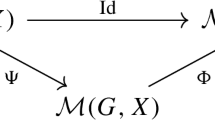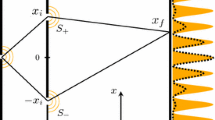First-order perturbation theory for the multiplication coeffi cient based on the method of characteristics in the form used in the MCCG3D code is presented. Finite-difference analogs of the perturbation theory formulas are derived using the difference scheme of the MCCG3D code. Test calculations were performed. It is shown that the results obtained by perturbation theory and direct calculations converge.
Similar content being viewed by others
References
G. I. Marchuk, Method for Calculating Nuclear Reactors, Gosatomizdat, Moscow (1961).
A. S. Seregin and T. S. Kislitsyna, Synopsis of the Program System TRIGEX–CONSYST–BNAB-90, Preprint FEI-2655 (1997).
I. Kodeli, “Multidimensional deterministic nuclear data sensitivity and uncertainty code system: Method and application,” Nucl. Sci. Eng., 138, No. 1, 45–66 (2001).
M. Williams and B. Rearden, “SCALE-6 Sensitivity/Uncertainty Methods and Covariance Data,” Nucl. Data Sheets, 109, No. 12, 2796–2800 (2008).
B. Rearden and M. Jessee (eds.), SCALE Code System, Vers. 6.2.2, ORNL/TM-2005/39 (2017).
I. R. Suslov, “Method of characteristics in regions with complex geometry,” At. Energ., 65, No. 1, 57–58 (1988).
A. Marin-Lafl eche, M. Smith, and Ch. Lee, “PROTEUS-MOC: a 3D deterministic solver incorporating 2D method of characteristics,” in: Int. Conf. Mathematics and Computation Methods Applied to Nuclear Science and Engineering, Sun Valley, Idaho, May 5–9, 2013, ID 7525.
W. Boyd, K. Smith, B. Forget, and A. Siegel, “Parallel performance results for the OpenMOC method of characteristics code on multi-core platforms,” in: Int. Conf. PHYSOR 2014, Japan, Sept. 28 – Oct. 3, 2014, ID 1104798.
I. R. Suslov, “Improvements in the long characteristics method and their effi ciency for deep penetration problems,” Prog. Nucl. Energy, 39, No. 2, 223–242 (2001).
H. Greenspan, C. Kelber, and D. Okrent, Computing Methods in Reactor Physics, Gordon & Breach Sci. Pub. Ltd, New York (1968).
I. V. Tormyshev and I. R. Suslov, “Conjugacy analysis of the fi nite difference equations of the method of characteristics on the basis of a linear algebraic formulation,” At. Energy, 122, No. 6, 369–376 (2017).
Benchmark on the VENUS-2 MOX Core Measurements, OECD/NEA Rep. (2000).
Author information
Authors and Affiliations
Corresponding author
Additional information
Translated from Atomnya Énergiya, Vol. 127, No. 4, pp. 229–232, October, 2019.
Rights and permissions
About this article
Cite this article
Suslov, I.R., Tormyshev, I.V. Perturbation Theory in the Method of Characteristics. At Energy 127, 255–258 (2020). https://doi.org/10.1007/s10512-020-00619-1
Received:
Published:
Issue Date:
DOI: https://doi.org/10.1007/s10512-020-00619-1




